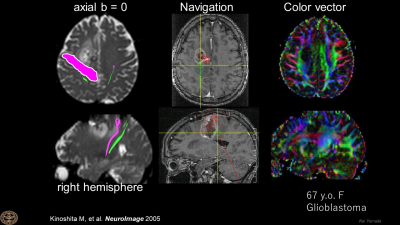DWI & DTI: Where, Why & How It Is & Is Not Used
Kei Yamada1
1Kyoto Prefectural Univ. of Medicine, Japan
Synopsis
Diffusion-weighted imaging (DWI)and
diffusion-tensor imaging (DTI) has become one of the essential
research/clinical tools in analyzing the brain in both normal and pathological
states. In this presentation, I will first cover the brief history of DWI, and
then explain how this tool has become an essential part of our daily practice.
Acknowledgements
No acknowledgement found.References
1. Mori S, et al. Three-dimensional tracking of axonal projections
in the brain by magnetic resonance imaging. Ann Neurol 1999; 45: 265-9
2. Yamada K. Diffusion tensor tractography should be used with
caution. Proc Natl Acad Sci U S A. 2009 106:E14
3. Kinoshita M, Yamada K, et al. Fiber-tracking does not
accurately estimate size of fiber bundle in pathological condition. Neuroimage.
2005 1; 25: 424-429.
Proc. Intl. Soc. Mag. Reson. Med. 30 (2022)
